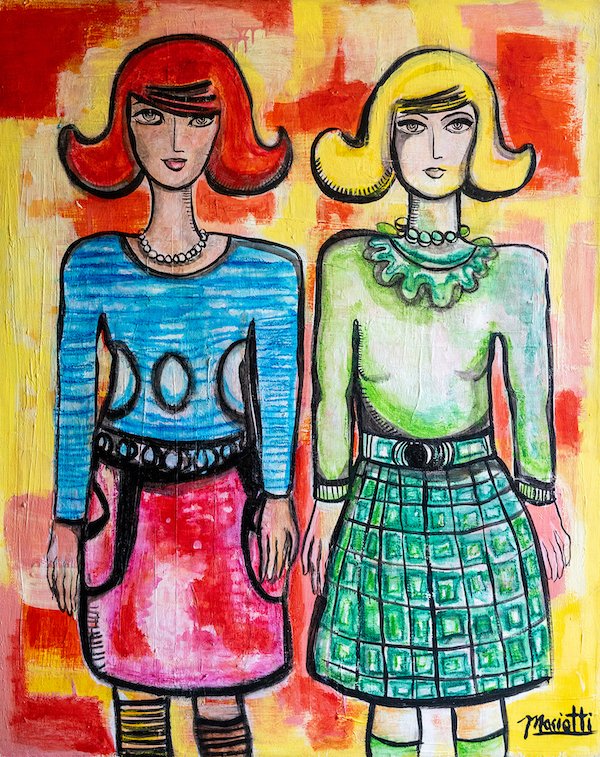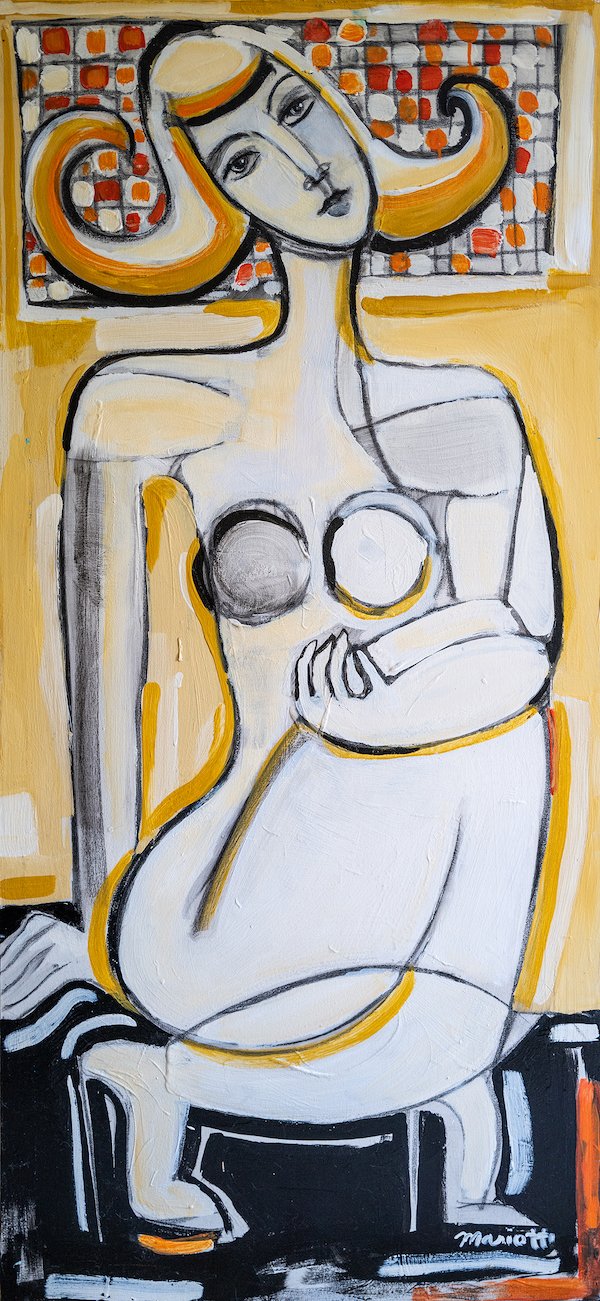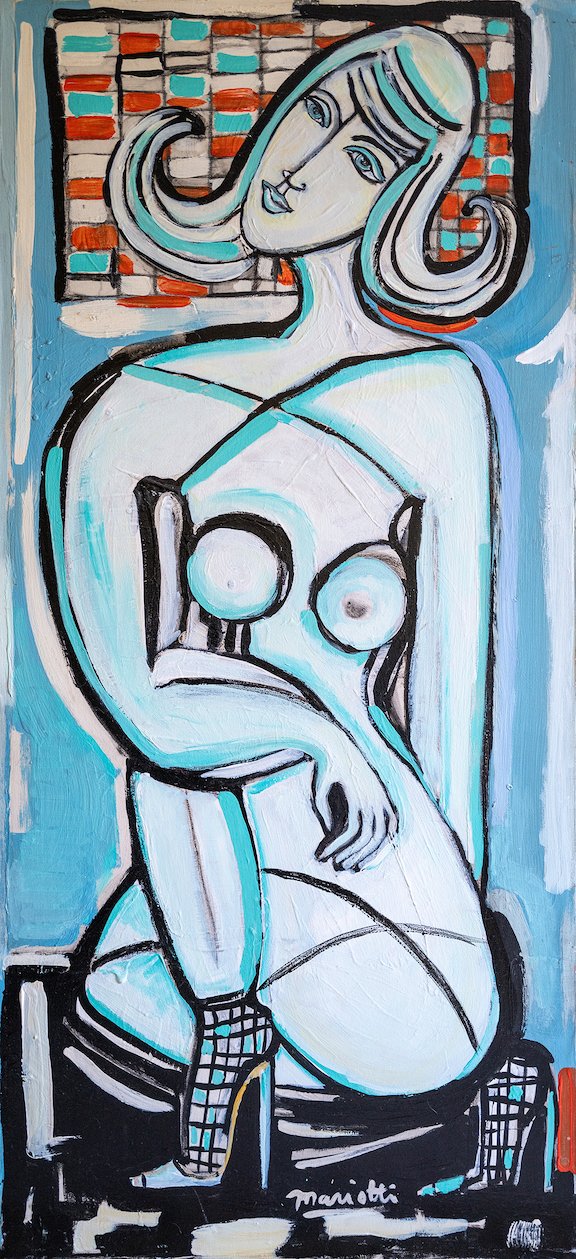Interview with artist Christina Mariotti
Christina Mariotti spent much of her youth in Italy, which not surprisingly influences much of her art today. She eventually moved to Fayetteville and earned a BFA in studio art. Christina’s paintings are often autobiographical and always celebratory. Her art has been featured in numerous in-person and online exhibitions. More of Christina’s work can be found at christinamariotti.com.

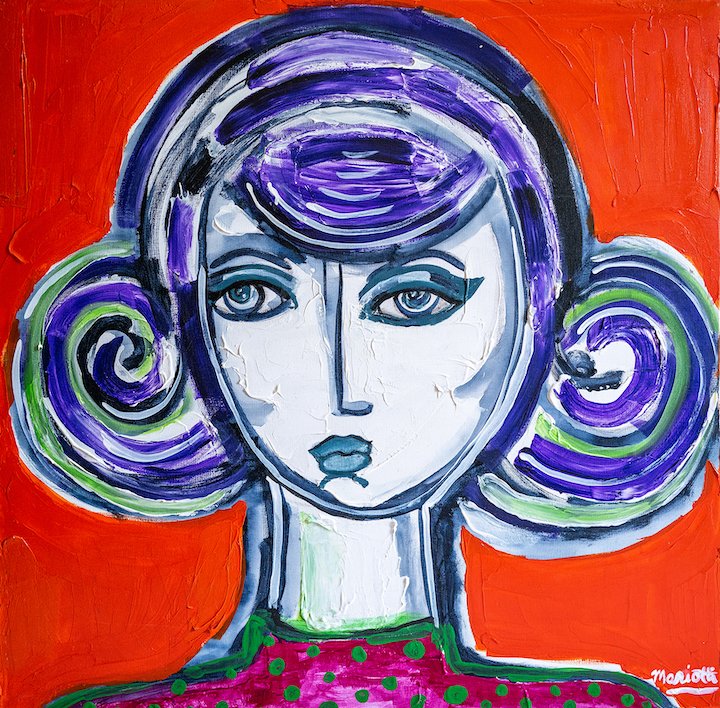
AAS: Christina, am I correct in saying you spent most of your youth in Italy? How did you eventually end up in Northwest Arkansas?
CM: Yes, I was born in Rome, Italy, to a Roman Italian father and an American mother, in the Trastevere area. At that time, it was a very poor area of Rome, but affordable for a young couple. My mother and father separated when I was 3 and a half years old, and she brought us back to the states. My mother later sent my older brother and me back to Italy to live with my great aunt and uncle, which was supposed to be just for that summer but turned out to be nearly four years. Those were some of the best times of my life. I experienced great love and care from my Italian family, developed my love for cooking, and was fully immersed in Roman culture. It was a huge influence on who I am now.
We came back to the states to live in Kansas City, Missouri with our mother for my teenage years. I later ended up in Northwest Arkansas while in a dating relationship with someone who was moving here, enrolled in the University of Arkansas School of Art and eventually earned my BFA in studio art. I was immediately captivated by the natural beauty here and quickly grew to love hiking and camping, later even buying some property near the Little Buffalo River. Northwest Arkansas has been my home since and I expect it always will be.
AAS: What was it like growing up in Kansas City after living in Rome?
CM: We came back from Rome for the second time to live in Kansas City when I was around 11 or 12 years old, so it was initially a culture shock for me. I remember I had clothes that my seamstress Italian grandmother had made, and I was very proud of those, but of course came back to a culture where everyone bought their clothes and I felt like I looked weird and had an accent.
Those were difficult years for me for a number of reasons in addition to the initially abrupt change of surroundings. There were difficult family problems resulting in me leaving home at a very young age, learning to take care of myself. I was diagnosed with a learning disability and struggled in school, but that really led me to retreat into a love of art that had begun in the streets and museums of Rome. Kansas City had the Nelson-Atkins Museum of Art and the Kansas City Art Institute, and I used to sneak out of the All Souls Unitarian Church on Sundays to go across the street to look at art, something my mother may still not even know.
I suppose I didn’t know it at the time, but through art I was realizing that my learning disability was only about difficulties with traditional learning environments, and that I was actually a natural student, very observant and curious. Art was my conduit for learning and growing and continues to be to this day. Art really saved me.
AAS: I recently spent several weeks in Italy. It is such an artistically inspirational place. When you were growing up, were your family supportive of your interest in becoming an artist?
CM: My father left us when I was an infant and was not involved in my life, and my mother and I had a difficult relationship. My Italian relatives were especially supportive of my interest in art, allowing me to sit and draw for hours and keeping me supplied with paper and drawing tools. My childhood in Italy was rich with exposure to arguably the greatest art in the world. My grandmother would routinely point out sights like the coliseum and the statue of David and the Basilica. I remember her having us get on our knees whenever the Pope was on television, because we were being blessed. Looking back, I find it kind of ironic to think that I was actually blessed to spend part of my life in Italy.
AAS: I want to talk first about I’m Free. It has some strong Eastern European symbolism.
I’m Free, 42” x 16”, acrylic and paper on canvas
CM: Being a product of dual cultures, I tend to look at art from the whole world. That piece, for me, represents a shedding of past troubles and struggles, and the freedom of shedding those things. It represents a liberation from those constraints, which really underlies a great deal of my work. I believe that struggle for freedom is a universally appealing theme that crosses gender, sexuality, and cultures. Everyone is struggling with something, no matter who they are, and I value the idea of making work that helps them feel they’re not alone in that struggle.
Art has meant so much to me. It forced me to get over my shyness and put my work out into the world to be judged, which isn’t easy. I don’t take naturally to self promotion. From a practical standpoint it became my way of making a living and has helped me survive and thrive. It fundamentally gave me purpose, which drives me to this day. It sustains me.
AAS: Another beautiful painting is Triad. In it, the imagery is almost mythological. What inspired that piece?
Triad, 48” x 36”, acrylic and mixed media on panel
CM: That piece is about something that happened to me at my job as a teacher. COVID was such a challenge, and we were not sure what was going to happen. When we got through it, I felt very empowered. That piece is a characterization of a mermaid or alien coming out of the ocean to reward us for getting through it all. I can’t really explain why she’s a mermaid, but I do know I have a love for mysterious, strong figures, especially women. I was creating my own mythology, I suppose, and in fact I do that routinely with my figurative work. I’m very proud of that.
AAS: In Reclining Nude, your almost archetypal feminine form pays homage to Picasso in a most charming and amusing way. Tell me about Reclining Nude.
Reclining Nude, 30” x 40”, acrylic and paper on canvas
CM: What I was trying to do is experiment with breaking up the figure into geometric shapes. In a way it was like architecture. I was also playing with color. I don’t believe I was intentionally mimicking Picasso, although I understand how it looks somewhat like that. Perhaps he was pursuing the same ideas in some of his figurative work.
I think you really identified the most important aspect of that work when you described it as an archetypal feminine form. I’m definitely continually pursuing various visual interpretations of that feminine archetype, driven by explorations of various cultures, fashions, etc. The thing they all have in common is strength and dignity. I think I’m interested in empowering not only myself as a woman, but all women, through my work.
AAS: Color is an important element in your figurative work and in many of your abstracts. This untitled work is one of my favorites. I really like the way it vibrates. What do you enjoy most about painting abstracts?
Untitled, 60” x 48”, acrylic on canvas
CM: My abstract work is purely physical or kinetic. It’s a balance of chaos and control. I’m moving paint around, spinning the piece around physically to control the motion of paint. What I respect about abstract work is that it’s as much about what you can’t control as what you can. It’s layers of complication, with all of the gods working together to help me arrive at the final piece. Sometimes I need that freedom away from the control of the figurative work.


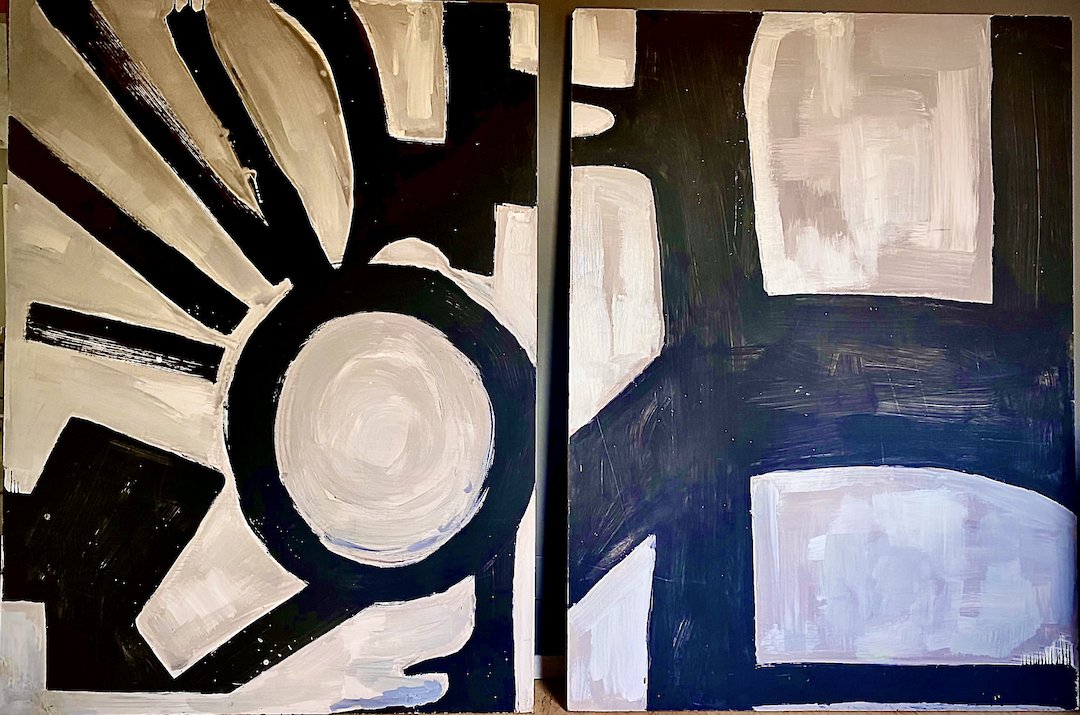
AAS: And something completely different is The Girl From the Wrong Side of the Block. Tell me about it.
The Girl From the Wrong Side of the Block, 48” x 48”, acrylic on panel
CM: That piece was originally an abstract piece and had sat in my studio for years as such. For some reason I felt unsatisfied with it, and it still felt as if it were a very adolescent attempt at an abstract piece. In looking back, I saw that piece as a reminder of how much I had learned since doing it. It sat dormant for years, then one day it struck me to layer the figurative image over it, the tough, resilient woman, layered over the past, celebrating what I had since learned. It was a magical moment for me. The woman in that piece was pissed off and elegant at the same time, which was how I felt at the time. I came from the wrong side of the block myself. I raised myself. I had to be tough. That comes out in my work continually.
AAS: Tell me about the teaching you do and how you feel it has impacted your art practice.
CM: I teach pre-K children at a private school. They are so uninhibited. They have not yet unlearned how to be creative. It comes naturally to them. Watching them inspires me. I try to bring the things that inspired me to the classroom. I believe they are far more capable of understanding the concepts of art than anyone realizes, and when I make that assumption, the results of their work are astounding.
By the time they get through my classroom they not only know how to use the tools, but they’ve been exposed to the work of some of the world’s greatest artists. I do it in a way that makes the art accessible for them at their level, and fun, taking advantage of their natural curiosity and desire to learn. I think it impacts the rest of their lives, whether they continue pursuing art or anything else. I know this is true because I run into so many of them as adults who tell me what my classes meant to them. I’m not only rewarded by what they learn from me but especially by what I learn from them. I would not trade the experience for anything. I have been transformed and enriched by it. Teaching really provides me with a purpose, stability, and a career that’s ideally compatible with my art career. I’m forever grateful for it.
AAS: Has the art scene in Northwest Arkansas enhanced your practice, especially as a female artist?
CM: The truth is that between my teaching job and my personal practice as an artist, I’ve not been able to be as involved in the Northwest Arkansas arts scene as I wish I had been. I’m somewhat introverted and shy about participating in much of that, although I think I’m known for my work regionally. I spend a lot more time working on commissions than participating in group exhibitions. I have accumulated a pretty large body of work and I hope to progress into more visibility as an artist in the coming years.
